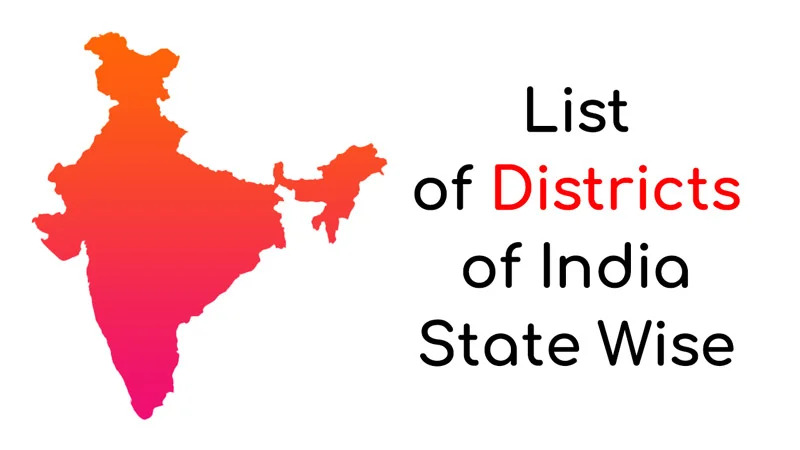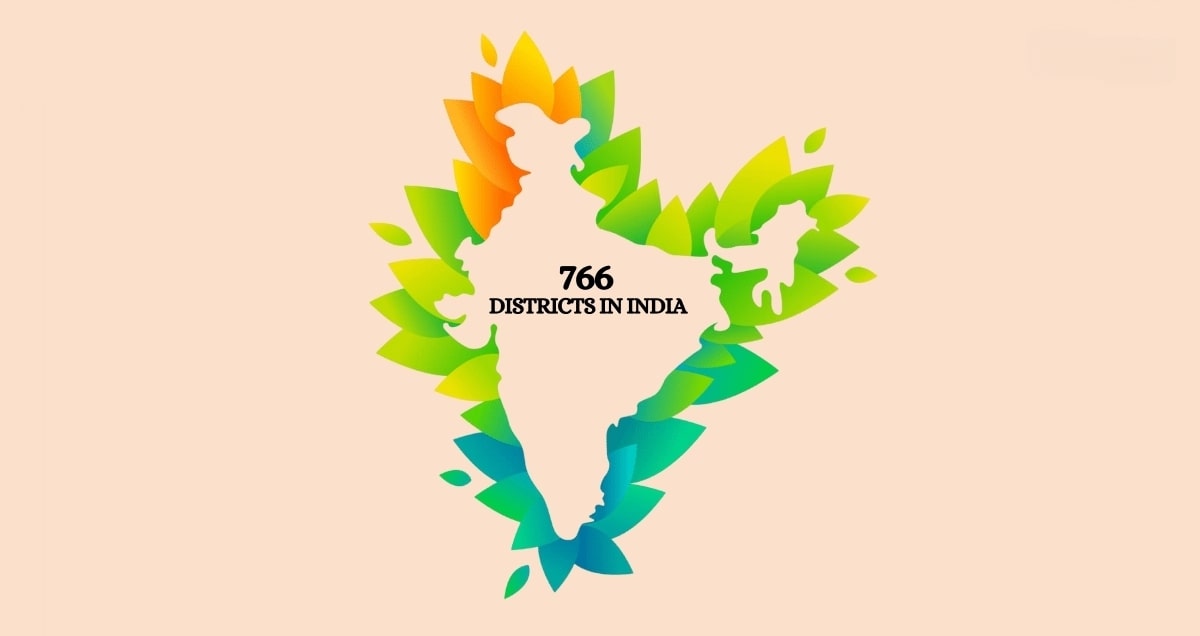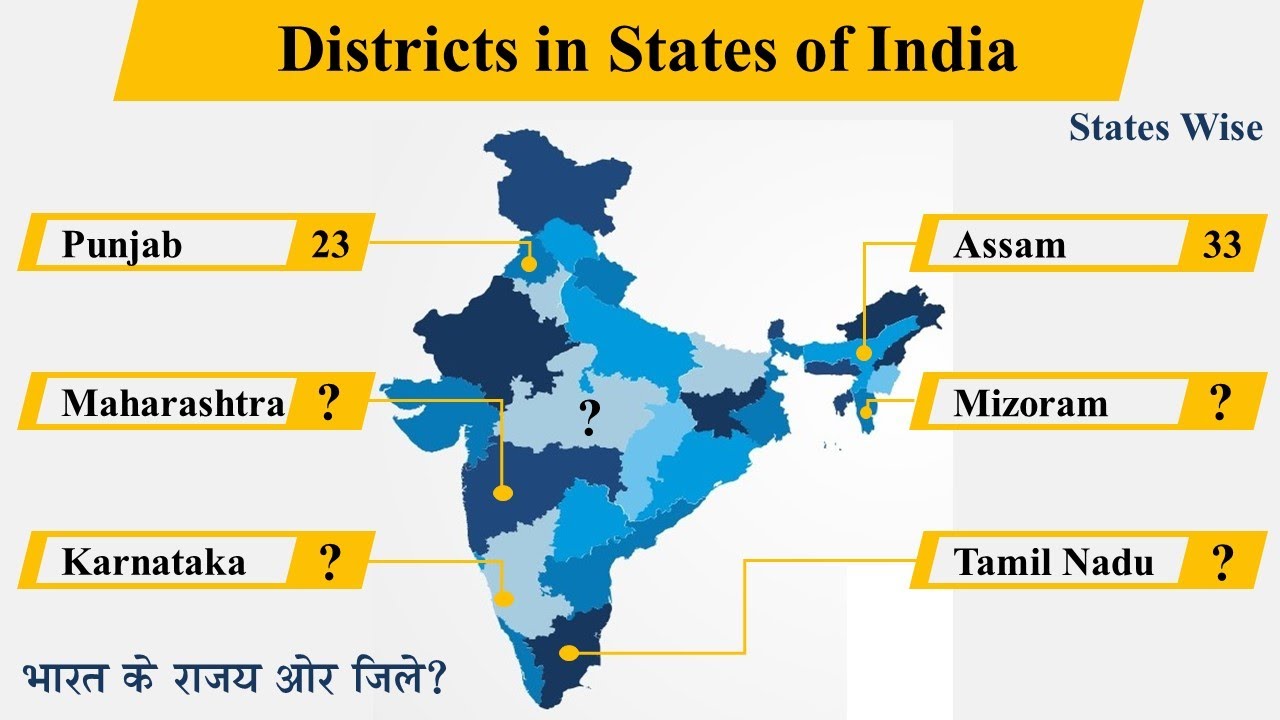university.nakul@gmail.com | Posted on
India, with its vast population and diverse geography, is divided into various administrative units to ensure smooth governance. These units, from states to smaller entities like villages, allow for localized management of resources and services. One of the most important administrative divisions is the district, playing a critical role in connecting local populations to state and central governance. In this post, we’ll explore how many districts there are in India, how they are formed, and their importance in the country's administrative framework.

What is a District?
A district is a key administrative unit in India, typically headed by a district magistrate or deputy commissioner. These officials, along with district-level officers, are responsible for enforcing laws, maintaining order, and ensuring that government schemes and services reach the people. Districts act as the bridge between state and local governments, facilitating administrative efficiency in smaller regions.
Districts are further subdivided into tehsils or talukas, which ensure even more localized governance. They oversee law and order, development, infrastructure, education, and public health, providing essential services and handling day-to-day administrative tasks.
How Many Districts Are There in India?
As of 2024, India has 800 districts, which continues to rise as states divide existing districts into smaller administrative units. This rise in district numbers is due to factors like population growth, urban expansion, and the need for more efficient governance.
The number of districts in India has seen a steady increase over the years. In 1950, when India became a republic, there were only about 300 districts. Today, the count has more than doubled, reflecting the country’s need for localized administration as its population and complexities have grown.
The Largest States by Number of Districts
Some states in India have a significantly higher number of districts due to their size and population density. Let’s take a look at the states with the most districts:
- Uttar Pradesh: As the most populous state, Uttar Pradesh has 75 districts, making it the state with the highest number of districts.
- Madhya Pradesh: With a vast land area, Madhya Pradesh has 55 districts, each of which helps manage its large rural and urban populations.
- Maharashtra: This state has 36 districts, managing both its densely populated cities like Mumbai and large rural areas.
- Bihar: Bihar’s population is spread over 38 districts, handling both agricultural and industrial sectors.
- West Bengal: The state has 23 districts, which manage the high population density and diverse regions within.
These states have high district counts because of the challenges posed by vast land areas, large populations, and the need for effective resource distribution.
Small States and Union Territories: Fewer but Well-Managed Districts
Smaller states and Union Territories, with smaller populations and more compact geographical areas, tend to have fewer districts. For example:
- Goa: This coastal state has just 2 districts, North Goa and South Goa, yet its administration is highly organized due to its smaller size and population.
- Sikkim: The northeastern state of Sikkim is divided into 4 districts, each responsible for the region’s mountainous terrain and distinct communities.
- Chandigarh: As a Union Territory and a city, Chandigarh is a single district in itself, reflecting its unique administrative status.
Even with fewer districts, these regions maintain efficient governance through closer-knit administration.

Recent Additions to India’s Districts
In recent years, several states have created new districts to manage population growth and provide better services to people in remote or underserved areas. Some notable examples include:
- Telangana: Since its formation in 2014, Telangana has increased its number of districts from 10 to 33. This move has helped improve local governance, especially in rural areas.
- West Bengal: West Bengal added new districts, bringing its current total to 23. This was part of an effort to streamline administrative operations and improve resource distribution.
- Rajasthan: Rajasthan, known for its vast desert regions, has also added new districts in recent years to enhance governance in its remote areas.
The creation of new districts allows state governments to better manage public services, distribute resources more effectively, and improve the quality of governance, especially in areas that were previously difficult to administer.
Why Are New Districts Created?
New districts are created in India to address various administrative challenges. Some key reasons include:
-
Population Growth: As populations grow, particularly in urban areas, existing districts become too large to manage efficiently. Creating new districts allows for more localized administration and better resource management.
-
Geographical Barriers: In states with diverse geography, such as mountainous regions, deserts, or coastal areas, it may be challenging to govern large regions from a single district center. New districts help overcome these challenges.
-
Improved Governance: Smaller districts allow for more efficient governance. Officials can focus on smaller populations, respond faster to local needs, and ensure that government schemes reach all corners of the district.
-
Political and Economic Reasons: Sometimes, districts are created to address regional demands for autonomy or to promote economic development in underserved areas.
The creation of new districts is typically a state-level decision and involves consultation with local communities, political leaders, and administrative officials.
Conclusion: Dynamic Structure of Indian Districts
India’s administrative structure is constantly evolving, and the creation of new districts reflects the country’s commitment to decentralized governance. With over 800 districts, India’s ability to manage its vast population and diverse geography relies heavily on the efficient functioning of these administrative units. As the nation grows, so will the number of districts, ensuring that local governance remains responsive, efficient, and in tune with the needs of the people.
India’s dynamic district structure highlights the importance of flexibility and adaptation in governance, ensuring that every corner of this vast country is well-served by its government.
0
0 Comment
| Posted on
As of August 21, 2024, India comprises a total of 800 districts, serving as the third-level administrative divisions within the country. Each district is typically named after its administrative center and plays a crucial role in local governance and administration.
Overview of Districts in India
Districts in India function under the jurisdiction of state governments and are essential for the implementation of government policies and programs. They are further subdivided into smaller units such as tehsils or talukas, which facilitate local administration.

District Distribution by State and Union Territory
Here is a breakdown of the number of districts in each state and union territory:
- Andaman and Nicobar Islands: 3 districts
- Andhra Pradesh: 26 districts
- Arunachal Pradesh: 25 districts
- Assam: 35 districts
- Bihar: 38 districts
- Chandigarh: 1 district
- Chhattisgarh: 33 districts
- Dadra and Nagar Haveli and Daman and Diu: 3 districts
- Delhi: 11 districts
- Goa: 2 districts
- Gujarat: 33 districts
- Haryana: 22 districts
- Himachal Pradesh: 12 districts
- Jammu and Kashmir: 20 districts
- Jharkhand: 24 districts
- Karnataka: 31 districts
- Kerala: 14 districts
- Ladakh: 7 districts
- Lakshadweep: 1 district
- Madhya Pradesh: 52 districts
- Maharashtra: 36 districts
- Manipur: 16 districts
- Meghalaya: 12 districts
- Mizoram: 11 districts
- Nagaland: 12 districts
- Odisha: 30 districts
- Puducherry: 4 districts
- Punjab: 23 districts
- Rajasthan: 33 districts
- Sikkim: 4 districts
- Tamil Nadu: 38 districts
- Telangana: 33 districts
- Tripura: 8 districts
- Uttar Pradesh: 75 districts
- Uttarakhand: 13 districts
- West Bengal: 30 districts
Notable Districts
Among these, certain districts stand out due to their size or population:
- Largest District by Area: Kutch, Gujarat – covering an area of approximately 45,652 km².
- Smallest District by Area: Mahé, Puducherry – with an area of just 8.69 km².
- Most Populous District: Thane, Maharashtra – with a population exceeding 11 million as per the last census.
- Least Populous District: Dibang Valley, Arunachal Pradesh – home to only about 8,004 residents.
Conclusion
The administrative structure of India is complex, with each district playing a vital role in governance at the local level. The number of districts can change over time due to administrative reforms or reorganization efforts by state governments. Understanding this structure helps in grasping how local governance operates in one of the world's largest democracies.
0
0 Comment
